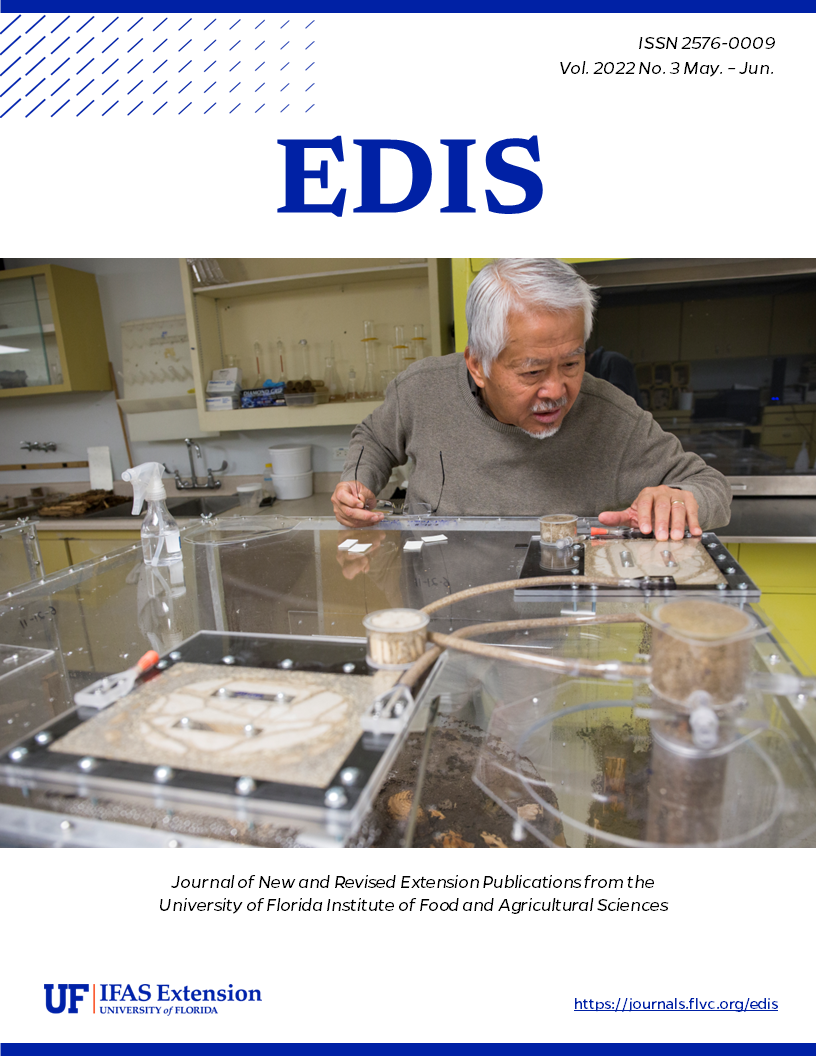Abstract
Florida is experiencing many human and climate-related changes to the aquatic environment that can affect fish. Lost or altered habitat, for instance, can lead to changes in fish populations that may impact survival, growth, or recruitment of those populations. Recruitment influences how many adult fish are later available for spawning and continuing the population. Understanding recruitment and how it is affected by ecological influences is important for considering the potential effects of ongoing climate change, as well as restoration and management of water quality and habitat. This publication provides background information useful to anyone interested in understanding more about factors affecting fish populations and should be especially useful to Extension agents and management agency personnel who would like an overview of these topics before engaging with stakeholders.
References
Albins, M., and M. Hixon. 2008. “Invasive Indo-Pacific Lionfish Pterois volitans Reduce Recruitment of Atlantic Coral-Reef Fishes.” Marine Ecology Progress Series 367:233–238. https://doi.org/10.3354/meps07620
Anderson, J. T. 1988. “A Review of Size Dependent Survival During Pre-Recruit Stages of Fishes in Relation to Recruitment.” Journal of Northwest Atlantic Fishery Science 8:55–66. https://doi.org/10.2960/J.v8.a6
Beck, M. W., R. Brumbaugh, L. Airoldi, A. Carranza, L. Coen, C. Crawford, O. Defeo, et al. 2011. “Oyster Reefs at Risk and Recommendations for Conservation, Restoration, and Management.” BioScience 61 (2): 107–116. https://doi.org/10.1525/bio.2011.61.2.5
Beck, M. W., K. L. Heck, K. W. Able, D. L. Childers, D. B. Eggleston, B. M. Gillanders, B. Halpern, et al. 2001. “The Identification, Conservation, and Management of Estuarine and Marine Nurseries for Fish and Invertebrates.” BioScience 51 (8): 633–641. https://doi.org/10.1641/0006-3568(2001)051[0633:TICAMO]2.0.CO;2
Bonvechio, T. F., and M. S. Allen. 2005. “Relations between Hydrological Variables and Year-Class Strength of Sportfish in Eight Florida Waterbodies.” Hydrobiologia 532 (1–3): 193–207. https://doi.org/10.1007/s10750-004-1388-y
Camp, E., A. B. Collins, R. N. Ahrens, and K. Lorenzen. 2020. “Fish Population Recruitment: What Recruitment Means and Why It Matters FA222. EDIS 2020 (2): 6–6. https://doi.org/10.32473/edis-fa222-2020
Camp, E. V., A. B. Collins, R. N. Ahrens, and K. Lorenzen. 2021. “Fish Population Recruitment 2: Stock Recruit Relationships and Why They Matter For Stock Assessment FA234. EDIS 2021(5). https://doi.org/10.32473/edis-fa234-2021
Doherty, P. J., and D. McB. Williams. 1988. “The Replenishment of Coral Reef Fish Populations. Oceanography and Marine Biology: An Annual Review 26:487–551.
Flaherty, K. E., and J. H. Landsberg. 2011. “Effects of a Persistent Red Tide (Karenia brevis) Bloom on Community Structure and Species-Specific Relative Abundance of Nekton in a Gulf of Mexico Estuary.” Estuaries and Coasts 34 (2): 417–439. https://doi.org/10.1007/s12237-010-9350-x
Flowers, H. J., W. E. Pine, B. T. van Poorten, and E. V. Camp. 2020. “Evaluating Population Recovery Characteristics and Potential Recovery Actions for a Long-Lived Protected Species: A Case History of Gulf Sturgeon in the Apalachicola River.” Marine and Coastal Fisheries 12 (1): 33–49. https://doi.org/10.1002/mcf2.10105
Gilbert, P. M., and M. A. Burford. 2017. “Globally Changing Nutrient Loads and Harmful Algal Blooms: Recent Advances, New Paradigms, and Continuing Challenges.” Oceanography 30 (1): 58–69. https://doi.org/10.5670/oceanog.2017.110
Hein, M. Y., R. Beeden, R. A. Birtles, T. J. Chase, F. Couture, E. Haskin, N. Marshall, et al. 2020. “Effects of Coral Restoration on Fish Communities: Snapshots of Long-Term, Multiregional Responses and Implications for Practice.” Restoration Ecology 28 (5): 1158–1171. https://doi.org/10.1111/rec.13177
Lenihan, H. S., C. H. Peterson, J. E. Byers, J. H. Grabowski, G. W. Thayer, and D. R. Colby. 2001. “Cascading of Habitat Degradation: Oyster Reefs Invaded by Refugee Fishes Escaping Stress.” Ecological Applications 11 (3): 764–782. https://doi.org/10.1890/1051-0761(2001)011[0764:COHDOR]2.0.CO;2
Lorenzen, K., and E. V. Camp. 2019. “Density-Dependence in the Life History of Fishes: When Is a Fish Recruited?” Fisheries Research 217:5–10. https://doi.org/10.1016/j.fishres.2018.09.024
Peterson, C. H., J. H. Grabowski, and S. P. Powers. 2003. “Estimated Enhancement of Fish Production Resulting from Restoring Oyster Reef Habitat: Quantitative Valuation.” Marine Ecology Progress Series 264:249–264. https://doi.org/10.3354/meps264249
Robbins, L. L., and J. T. Lisle. 2018. “Regional Acidification Trends in Florida Shellfish Estuaries: A 20+ Year Look at pH, Oxygen, Temperature, and Salinity.” Estuaries and Coasts 41 (5): 1268–1281. https://doi.org/10.1007/s12237-017-0353-8
Sogard, S. M. 1997. “Size-Selective Mortality in the Juvenile Stage of Teleost Fishes: A Review.” Bulletin of Marine Science 60 (3): 1129–1157.
zu Ermgassen, P. S. E., J. H. Grabowski, J. R. Gair, and S. P. Powers. 2016. “Quantifying Fish and Mobile Invertebrate Production from a Threatened Nursery Habitat.” Journal of Applied Ecology 53 (2): 596–606. https://doi.org/10.1111/1365-2664.12576

